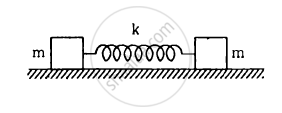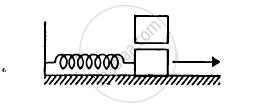Advertisements
Advertisements
प्रश्न
Find the displacement of a simple harmonic oscillator at which its P.E. is half of the maximum energy of the oscillator.
उत्तर
Let us assume that the required displacement is x.
∴ The potential energy of the simple harmonic oscillator = `1/2 kx^2`
Where, k = force constant = `mω^2`
∴ P.E. = `1/2 mω^2x^2` ......(i)
The maximum energy of the oscillator
TE = `1/2 mω^2A^2` [∵ xmax = A] ......(ii)
Where, A = Amplitude of motion
Given, P.E. = `1/2` TE
⇒ `1/2 mω^2x^2 = 1/2 [1/2 mω^2A^2]`
⇒ `x^2 = A^2/2`
or `x = sqrt(A^2/2) = +- A/sqrt(2)`
Sign ± indicates either side of mean position.
APPEARS IN
संबंधित प्रश्न
A particle executes simple harmonic motion with an amplitude of 10 cm. At what distance from the mean position are the kinetic and potential energies equal?
Consider a particle moving in simple harmonic motion according to the equation x = 2.0 cos (50 πt + tan−1 0.75) where x is in centimetre and t in second. The motion is started at t = 0. (a) When does the particle come to rest for the first time? (b) When does he acceleration have its maximum magnitude for the first time? (c) When does the particle come to rest for the second time ?
Find the elastic potential energy stored in each spring shown in figure, when the block is in equilibrium. Also find the time period of vertical oscillation of the block.
Consider the situation shown in figure . Show that if the blocks are displaced slightly in opposite direction and released, they will execute simple harmonic motion. Calculate the time period.

A 1 kg block is executing simple harmonic motion of amplitude 0.1 m on a smooth horizontal surface under the restoring force of a spring of spring constant 100 N/m. A block of mass 3 kg is gently placed on it at the instant it passes through the mean position. Assuming that the two blocks move together, find the frequency and the amplitude of the motion.

When a particle executing S.H.M oscillates with a frequency v, then the kinetic energy of the particle?
A body is executing simple harmonic motion with frequency ‘n’, the frequency of its potential energy is ______.
A mass of 2 kg is attached to the spring of spring constant 50 Nm–1. The block is pulled to a distance of 5 cm from its equilibrium position at x = 0 on a horizontal frictionless surface from rest at t = 0. Write the expression for its displacement at anytime t.
An object of mass 0.5 kg is executing a simple Harmonic motion. Its amplitude is 5 cm and the time period (T) is 0.2 s. What will be the potential energy of the object at an instant t = `T/4` s starting from the mean position? Assume that the initial phase of the oscillation is zero.
The total energy of a particle, executing simple harmonic motion is ______.
where x is the displacement from the mean position, hence total energy is independent of x.
